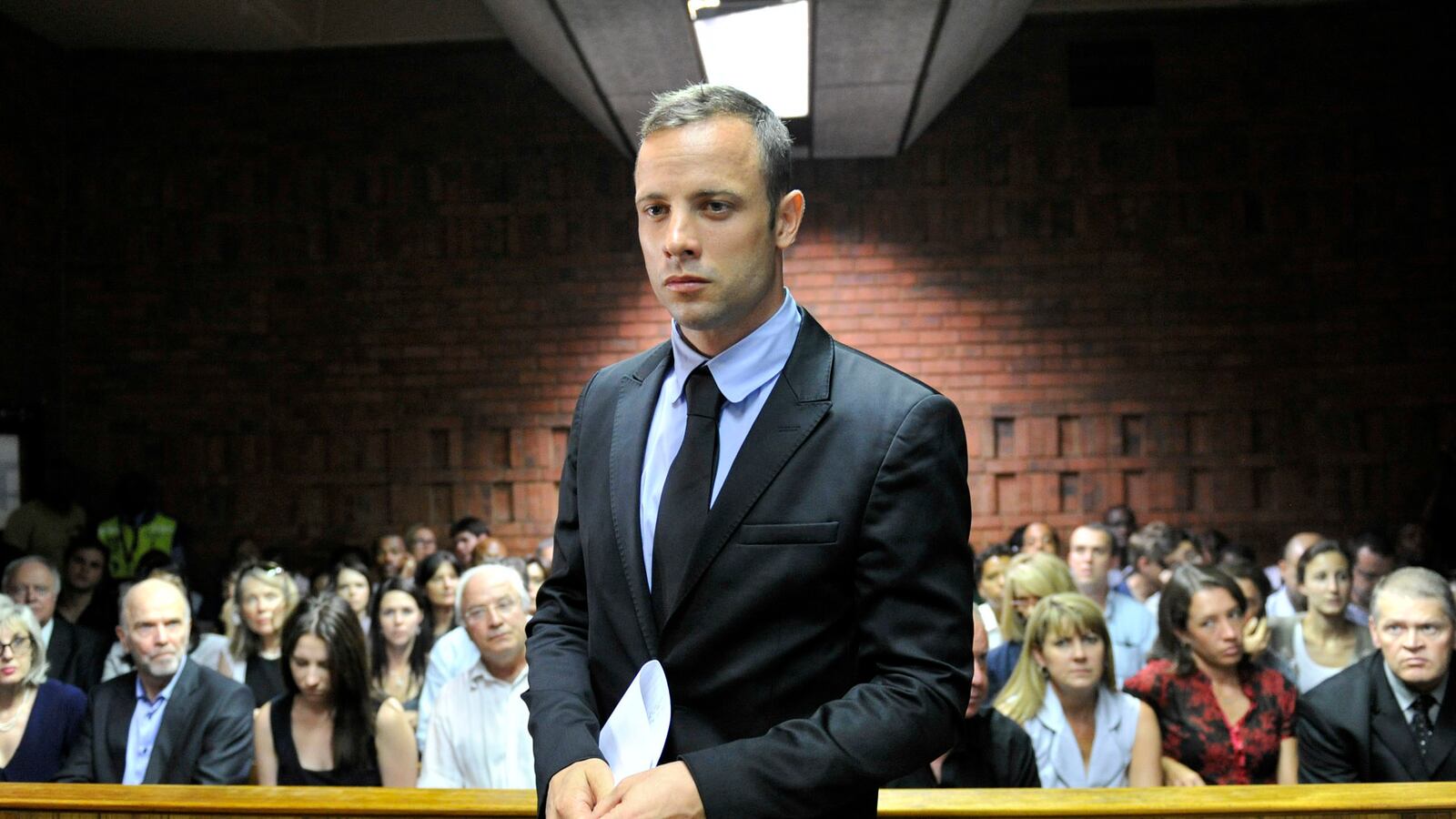If you believe South African Paralympic running champion Oscar Pistorius, nicknamed the Blade Runner for his incredible speed on prosthetic legs, he awoke at his home in a gated community in Pretoria during the early hours of Valentine’s Day to close the door of his balcony, then heard a strange noise coming from inside his bathroom. The six-time Paralympic gold medalist says he grabbed his 9mm pistol and plodded to the bathroom in the dark, gripped by fear and feeling vulnerable without his legs on. He then fired four shots through the door, believing the person inside was an intruder.

It wasn’t. Pistorius had shot his model and law-graduate girlfriend, Reeva Steenkamp, whom he said he thought was still in bed. Bullets pierced her skull and shattered her right elbow and hip bones.
Then, according to the athlete, he picked up her body in a panic and ran downstairs to get help. “I tried to render the assistance to Reeva that I could, but she died in my arms,” he said during a bail hearing this week. By the time paramedics and police arrived, at around 4:15 am, Steenkamp was dead, her body covered with bloody towels. Postmortem examinations later showed no signs of assault or defensive wounds on her body.
Whether that’s all there is to the story of Reeva Steenkamp’s death, however, remains to be seen. The case became even more complicated Thursday, when South Africa police said the lead investigator, Detective Hilton Botha, faces attempted-murder charges in an October 2011 shooting. The AP reported that Brig. Neville Malila said Botha is scheduled to appear in court in May on seven counts of attempted murder. Malila said Botha and two other police officers fired shots while trying to stop a minivan.
At the bail hearings, meanwhile, new details about the Steenkamp murder and the circumstances surrounding it emerged, including the presence of unlicensed ammunition and possible testosterone supplements, and witnesses who say they heard fighting before the shooting. Here’s what we know so far about the case against Oscar Pistorius.
Pistorius may have lied about not having his prosthetic legs on at the time of the shooting.
Pistorius maintains that he hobbled to the door of his bathroom without his carbon-fiber “blade” legs, which left him feeling vulnerable and afraid. Preliminary ballistic evidence, however, showed that the bullets were fired from an angle toward the toilet, which would have been difficult for Pistorius to achieve without his prosthetic legs. Prosecutor Gerrie Nel asked Detective Botha, “You were there, what was the angle?” Botha replied, “Seems to me down. Fired down.” “Through the top part of the door, not the bottom?” Nel pressed. “Definitely,” said Botha.
Testosterone supplements may have been found in Pistorius’s home.
During Wednesday’s bail hearing, Botha said investigators found two boxes of testosterone in the bedroom, along with syringes and needles. Testosterone is a banned substance for most athletes and is known to make its users more aggressive. During cross-examination, however, detective Botha admitted he “didn’t read the whole name on the container.” Defense lawyer Barry Roux explained that what police mistook for testosterone actually was an herbal supplement called testo-compositum enzyme, which is not banned. Tests on the substance have not yet been completed.
Witnesses say they heard “nonstop shouting and fighting” shortly before the shooting—but there’s reason to doubt what they heard.
Also during the hearing, prosecutor Nel said one witness saw lights on in the house (contradicting Pistorius’s account about hobbling to the bathroom in pitch-darkness, which kept him from seeing that Reeva was no longer in bed). Another witness, said Nel, “heard nonstop shouting and fighting between 2 and 3 a.m.” But during his cross-examination, Botha admitted that the witness who claimed to hear shouting lives a whopping 2,000 feet away, possibly out of earshot. After a break for lunch, the detective then amended this estimate to 1,000 feet.
The gun’s holster was found under Steenkamp’s side of the bed, suggesting Pistorius must have realized she was no longer in bed.
Detective Botha also told the court that the holster for the 9mm pistol used to kill Steenkamp was found under the left side of the bed, the same side where the 29-year-old model had been sleeping, suggesting that Pistorius had to see that Reeva was no longer in bed. The prosecution also projected a floor plan of the bedroom and bathroom in the courtroom, arguing that to reach the bathroom, Pistorius would have had to walk past his bed—which he could not have done without seeing that Steenkamp was not in it. “There’s no other way of getting there,” Nel said. However, the defense argued that because of an injury Pistorius had sustained on his right shoulder, he wore a “medical patch” that actually forced him to sleep on the left side of the bed that night, enabling him to go straight from the bed to the bathroom without crossing the area where he thought Steenkamp lay.
Illegal ammunition also was found in the home.
Whether or not he will be convicted of premeditated murder, Pistorius does have one other crime stacked up against him: he had no license for the 9mm pistol, making his possession of .38-caliber ammunition, which he kept in a safe in his bedroom, illegal.
Reeva’s bladder was empty when she was shot—consistent with Pistorius’s story.
In a statement read Tuesday by his lawyer, Pistorius said he believes Steenkamp slipped into the bathroom when he got up in the middle of the night to close the balcony door. The defense team believes Steenkamp then locked the door of the bathroom after she heard Pistorius yelling for the “intruder” to leave. In keeping with the story, defense lawyer Roux said Wednesday that Steenkamp’s bladder was empty at the time of her death, suggesting she really had gone to the bathroom. He also said Pistorius used a cricket bat to break down the door of the bathroom to get to his girlfriend and help her—and indeed, police found a bloody cricket bat that they believe was used to get to Reeva after the shooting.
In the end, Detective Botha confessed that police had not found anything inconsistent with Pistorius’s version of events.
Earlier, Detective Botha contradicted Pistorius’s account about hobbling to the door on his stumps by testifying to the prosecution that the trajectory of the bullets showed the gun was fired from a height. But when asked if police had found anything inconsistent with the version of events presented by Pistorius, he eventually conceded that they had not.





